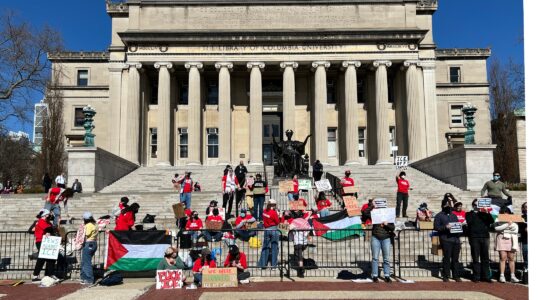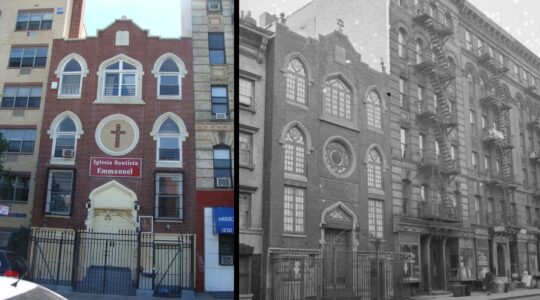On a philosophical level, Lincoln Square Synagogue’s leaders have been thinking about how much, or little, of the congregation’s history — including physical artifacts — should be incorporated into its new building.
On a practical level, they are facing an immediate issue, if not crisis, of what to do about the unique Aron Kodesh, or holy ark, that has been the signature symbol of its main sanctuary since 1995. A large wooden structure, the ark opens to a brightly lit space where eight Torah scrolls rest, each in place in an ascending ladder that revolves when touched lightly.
The $100,000 ark was designed and constructed by artist and architectural designer Edward Jacobs at the request of the late Martha Cohen, a longtime member of the synagogue and its staff, as a gift in memory of her parents, who perished in the Holocaust. The ark evokes warm feelings among many members who both remember Cohen fondly and marvel at its unique qualities; but others find the design impractical and too kitschy.
Some time ago the leaders of the congregation decided that the synagogue’s new main sanctuary should have a new ark befitting its surroundings, but that it would be appropriate to have the old ark placed in the Beit Midrash, or study hall where weekday and alternative Shabbat services would be held.
But for whatever reason — intentional or due to oversight, depending on whom you ask — no action was taken until quite recently.
Jacobs, who lives in Israel and is the son-in-law of Shlomo Riskin, Lincoln Square’s founding rabbi, is deeply upset at the possibility that the ark might be left behind and have to be dismantled and buried, the halachic requirement for unwanted sacred items.
Synagogue officials say that is a last-resort option and that they have been trying for many months to determine the means and costs of moving the ark, either into the new Beit Midrash or into storage until another home for it is found, perhaps in another synagogue, yeshiva or museum.
Since the ark was built into the ceiling and anchored into the floor of the sanctuary, various structural engineers have been unable to give the congregation’s leaders an accurate estimate of what is involved. Jacobs says he could have overseen the operation personally but was not asked, other than one e-mail query 18 months ago to inquire whether he would be willing to remove two feet off the top of the ark so it could fit into the new Beit Midrash. He said no, adding that it would fit in the space as is.
Jacobs says he is still willing to fly to New York and supervise the delicate task; he estimates it would cost about $30,000 to dismantle, crate and transport the ark to a storage site for several months while a final decision is made about its fate.
Synagogue leaders say Jacobs declined to get involved after learning the ark was not being considered for the new main sanctuary, and it is only now, in the midst of the complicated move, that he has spoken up. They have balked at the potential expense, unknown until Jacobs’ estimate this week, which does not deal with possibly transporting and installing the ark in the new building. Lincoln Square officials say that in the last two years they have been stringent about finances.
Both sides agree they are up against a tight deadline; the congregation must be out of its current building in the next few days.
“When you say the words ‘kodesh’ [as in Aron Kodesh, or holy ark] and ‘disposed of’ in the same sentence, people go crazy,” notes Richard Kestenbaum, the president of Lincoln Square.
“We’ve been struggling with this issue for a long time, and it is part of dealing with our history — past and future.”
He said he was hopeful a good solution could be found to honor the ark and Cohen’s memory.
The New York Jewish Week brings you the stories behind the headlines, keeping you connected to Jewish life in New York. Help sustain the reporting you trust by donating today.




